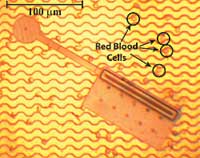May 14 2008
Nanosoccer returns to the field later this month, when the National Institute of Standards and Technology (NIST) hosts for the second time the world’s most Lilliputian sport. Three student teams will participate in a public exhibition at the 2008 U.S. “RoboCup Open” in Pittsburgh, Pa., May 25 to 27, where miniature “soccer players” - computer-driven robots six times smaller than an amoeba operating on a field the size of a grain of rice - will show off their skills.
 A photograph of a typical nanosoccer robot compared in size to red blood cells. About 200 of these robots could stretch in a line across the top of a plain M&M candy. Credit: Craig McGray
A photograph of a typical nanosoccer robot compared in size to red blood cells. About 200 of these robots could stretch in a line across the top of a plain M&M candy. Credit: Craig McGray
The teams from Carnegie-Mellon University (Pittsburgh, Pa.), the U.S. Naval Academy (Annapolis, Md.) and the University of Waterloo (Waterloo, Ontario, Canada) will meet at the Carnegie Science Center in Pittsburgh, Pa., to put their nanobots (nanoscale robots) through their paces. The nanobots will be demonstrating agility, maneuverability, response to computer control and ability to move objects - all tools that future miniaturized mechanized workers will need for tasks such as microsurgery within the human body or the manufacturing of atom-sized components for microscopic electronic devices.
RoboCup is an annual international competition designed to foster innovations and advances in artificial intelligence and intelligent robotics by using the game of soccer as a testing ground. NIST’s goal in coordinating competitions between the world’s smallest robots is to show the feasibility and accessibility of technologies for fabricating MicroElectroMechanical Systems (MEMS), tiny mechanical devices built onto semiconductor chips and measured in micrometers (millionth of a meter).
The soccer nanobots are operated by remote control under an optical microscope. They move in response to changing magnetic fields or electrical signals transmitted across the microchip arena. Although the bots are a few tens of micrometers to a few hundred micrometers long, they are considered “nanoscale” because their masses range from a few nanograms to a few hundred nanograms. They are manufactured from materials such as aluminum, nickel, gold, silicon and chromium.
Among the nanosoccer drills that will be demonstrated in Pittsburgh are the two-millimeter dash in which nanobots seek fast times for a goal-to-goal sprint across the playing field; a slalom course where the path between goals is blocked by “defenders” (polymer posts); and a ball handling exercise that requires robots to move “nanoballs” (spheres with the diameter of a human hair) into the goal. One team even plans to conduct its runs underwater to lessen friction.
RoboCup and NIST are jointly organizing the upcoming U.S. Open nanosoccer demonstration as the final step toward the first official Nanogram League competition for soccer nanobots at the 2009 international RoboCup event in Austria.
For more information about NIST and nanosoccer, see “2007 RoboCup Nanogram Demonstration Competition”.